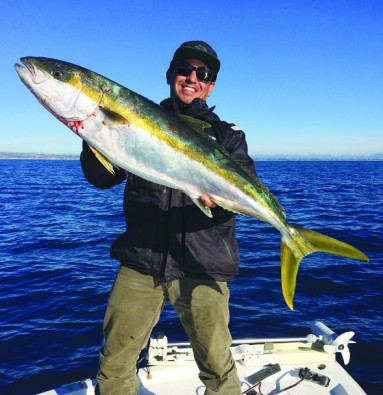 Red sky filled the horizon to the east as we slowly motored down the 40-fathom ridge. The Furuno split screen was set on both plotter and depth, and I was looking for “the corner” on the southwest side of the ridge where the hard bottom area turns toward the beach. The 63-degree, clean, blue water confirmed what the SST (sea surface temperature) and chlorophyll (plankton) charts reported the previous night. There were just a handful of private boats this early and about 90 percent of them were following a couple sportboats around that were making their first tacks with the sonar.
Red sky filled the horizon to the east as we slowly motored down the 40-fathom ridge. The Furuno split screen was set on both plotter and depth, and I was looking for “the corner” on the southwest side of the ridge where the hard bottom area turns toward the beach. The 63-degree, clean, blue water confirmed what the SST (sea surface temperature) and chlorophyll (plankton) charts reported the previous night. There were just a handful of private boats this early and about 90 percent of them were following a couple sportboats around that were making their first tacks with the sonar.
Stopping momentarily in the dark, my boat drifted uphill, which was a good sign for the area we were fishing that day. When the current is pushing uphill, this particular corner concentrates all sorts of fin bait on the up-current side of the structure. All this food also attracts gamefish, especially big, fat, wintertime yellowtail.
Slowly circling the corner of the ridge, I started seeing clouds of bait right off the bottom. As soon as the bait marks ended, I marked our first yellowtail on the sounder and quickly put the throttle in reverse and bumped the boat back five yards. I then hit the MOB (man overboard button) and grabbed my jig outfit. My friends had already reached bottom by the time I was at the rail, and eight cranks off the bottom the first blue/white Salas 6x was stopped in its tracks–”Fish on!” After a short pause, the heavy tail beat and bend of the rod confirmed we found what we were looking for–big wintertime yellows.
Do Your Homework
The wintertime yellowtail fishery we experience along the Southern California coast is something unique. It’s almost as if the yellowtail schools that used to spend their winter deep along the Baja coast have shifted west and chosen new spots of deep structure and ridges in Southern California as their winter home. Enjoy it while you can because—having fished here since the late 1970s—in my lifetime I have never witnessed such quality yellowtail fishing along our coast.
First, and most importantly, the key to being successful in this fishery on a private boat is to do your homework. Start by researching the area you plan to fish. This winter, schools of yellowtail have been foraging in 30 to 50 fathoms on hard bottom areas with structure from San Diego on up to Santa Barbara. Especially productive are the dozens of rockfish spots and ridges in this depth range.
Before choosing an area to fish, study the water near your home port. Two things that you are looking for is water temperature over 60 degrees and clean blue color. Since the water has not dropped below 60 degrees this winter, I can’t give you an honest answer if they will bite below that or move on. As for water color, in deep water I prefer clean blue but have also had some epic trips in clean green along the coast.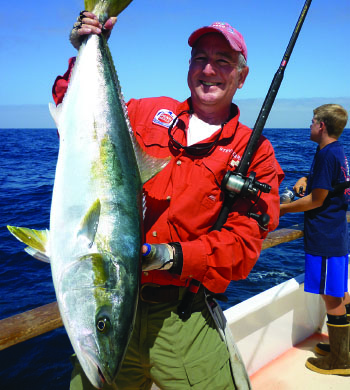
Next, try to get an update on how the bite was the day prior to your trip. Ask the proper questions: time of day for bites, what depth, water temperature/color for bites, jigs or bait, what part of ridge or structure was best, where was the boat pressure, seal problems and any other useful info that will help you be successful.
Private Boat Tactics
It is much more rewarding to find your own fish than follow a sportboat around that is typically using sonar to locate schools of yellowtail. My advice is if you want to fish with sonar, buy a ticket on a sportboat and enjoy being an angler and learn from their crew how to catch more fish. I always learn something new when I ride a sportboat.
It’s a great way to also see what not to do from a sportboat captain’s perspective. The deadliest sin of all is to run along out in front of a sportboat, which disrupts the craft’s sonar screen and ability to mark fish. A close second would be to cut in front of a sportboat when they mark fish on the sonar and go into their chum circle. Very bad idea on all fronts and it ruins the bite for both boats.
On a private boat, once you mark a school of fish on the sounder, without sonar we have no way of knowing which direction the school is headed and lack the live bait capacity to chum the school up the water column. With that being said, on my private boat we are strictly a “mark, drop and hook” kind of program.
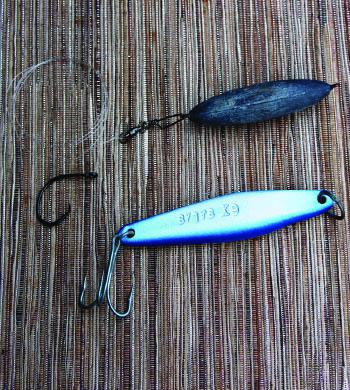 If you have done your homework on an area, being able to read the contours and find small isolated stones or structure within a hard bottom area is the key to success. I keep my eyes glued to the plotter and sounder and hit MOB anytime I mark an area of interest. As you slowly work up and down an area, it’s like connecting the dots on the plotter and eventually you are going to stumble over a school of fish. If you are not marking fish but seeing good signs of bait and structure on the sounder,consider a blind drift. My boat partner did just that on a recent client trip and put two fat yellowtail onboard on his first drift.
If you have done your homework on an area, being able to read the contours and find small isolated stones or structure within a hard bottom area is the key to success. I keep my eyes glued to the plotter and sounder and hit MOB anytime I mark an area of interest. As you slowly work up and down an area, it’s like connecting the dots on the plotter and eventually you are going to stumble over a school of fish. If you are not marking fish but seeing good signs of bait and structure on the sounder,consider a blind drift. My boat partner did just that on a recent client trip and put two fat yellowtail onboard on his first drift.
I have seen it many times where a sportboat can lead a school of yellowtail on the sonar while shoveling sardines into the circle and, like magic, the fish rise from 40 to 25 fathoms and start blowing up on surface baits. I have never witnessed a private boat without sonar perform that same task. However, what private boats lack in bait capacity they make up in being able to cater our fishing time to the best bite times. For example, if it’s a late afternoon or early evening bite, the private boats can stay on the area and fish through the tide or bite time when most the sport fleet has already gone home.
Another tip for a private boater is prospecting the inner part of the ridge in the morning during an offshore or northeasterly wind. Many times the fish will leave the area at night and migrate back into the hard bottom areas in the morning to feed. Many times they will move inside to feed around a squid nest at night and then move back out to deep water to forage during the day. Prospecting along these transition areas is a good way to locate fish early.
Gear for Deep Water Yellowtail
These wintertime deep water yellowtail are much stronger and smarter than the summertime fish you find under kelps or at the islands. They got big for a reason: They have eluded capture by humans and predators and know every trick in the book.
On deep water trips, I tell my fishing buddies to bring three outfits: one 40-pound outfit and two 50-pound outfits—and all with braid backing and short 50- to 75-foot monofilament top shots. Sure, you can occasionally land a big one on light tackle, but if you really want to land these deep water fish leave your light tackle at home. I don’t recommend fishing anything less than 30-pound test line if you want to land a couple fish.
The fishing techniques are very basic–you will be either fishing the yo-yo jigs (more on this later) or a dropper loop rig with a live mackerel or sardine. A couple other key items to have along for the trip are some back-up iron jigs, torpedo weights, circle hooks in sizes 3/0 to 6/0, a proper gaff and a fish bag with 20 to 40 pounds of ice for a day trip.
Yo-Yo Techniques
My favorite way to fish deep water yellowtail is with the yo-yo jig. For deep water, my two go-to irons are the Salas 6x heavy and the Tady 4/0 heavy. White, blue/white, scrambled egg and even white/orange (rockfish) have been productive. For whatever reason, I have not had good success with chrome, though I have seen plenty of nice yellows caught on this color. These heavy iron jigs work best in the 40- to 50-fathom range, plus they get down into the zone quickly. If there is heavy current or fishing deeper than 50 fathoms, try a Salas PL68. It’s deadly on the bigger fish, too!
For 30 to 40 fathoms, I like the Salas 6x Jr and the Tady 9 in the same colors. When on my boat, I also bring a spinning outfit rigged up with a Salas Christy II, which I can fire out into breaking fish or schools of yellows that respond to chum and rise up to the middle in the water column. Since I get asked all the time about this particular spinning outfit, my Penn Spinfisher 4500 on a Penn Carnage 20-50 Jigging rod has boated dozens of yellowtail to 30 pounds. Try it, you might like it!
I use either a San Diego jam knot or four turn Uni knot tied to the front ring eye of the iron jig. Occasionally, if I am fishing the yo-yo jig all day long, I like to put a small black barrel swivel six feet in front of jig to help prevent line twist. This will not affect the action of the lure and gets bit just fine with the short leader.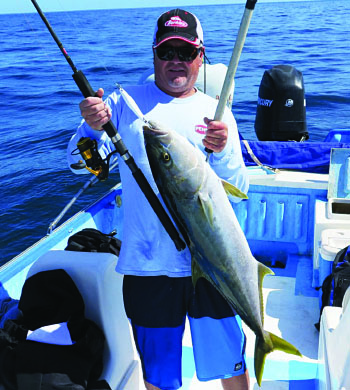
As for reels, I recommend a tall and narrow reel for yo-yo fishing. Along with a reel that has a range of gear ratios from 4.3:1 to 6:1, a tall and narrow spool will increase your inches per a crank when compared to reels that are shorter and wider when you are fishing in deep water and one third or more of your line is out to reach bottom.
I am a Penn guy and my favorite reel for this application is the new US Senator 113N (Baja Special); it’s a narrow and tall 4/0N star drag reel with a 4.3:1 gear ratio and a big handle to crank jigs all day. When combined with a seven-foot heavy action graphite rod (700MH or 700H), you have yourself an outfit that will get the job done. When I fish on a sportboat, I switch the seven-foot rod out with an eight-foot model (800ML or 800M)–with the extra foot of length helping work fish around the bow and up and over passengers when following a fish.
Fill your reel with a quality braid and then add a 50- to 75-foot top shot of clear, abrasion-resistant monofilament. I use white 50- or 65-pound test Berkley Pro Spec Braid for backing. As I said before, make sure your mono top shot fills the reel to the top of the spool, which will help keep the spool diameter full on deep drops.
For top shots, I started using Berkley Big Game 40- or 50-pound monofilament for two reasons. First, the abrasion resistance of monofilament helps protect the line on the initial bite when the yellowtail runs for the nearest structure. Secondly, a monofilament top shot also allows you to apply extreme pressure on the fish when the yellowtail is straight up and down under the boat without pulling the hook. Monofilament has a slight stretch to it and it can play into your advantage on the end game.
Keep your jig in the bite zone! Depending on what depth you mark fish on the sounder, on a private boat you want to cast your jig 10 to 20 feet off the down-wind stern corner. As the jig sinks and the boat drifts your line angle will be straight up and down off the stern. Be ready to put the reel in gear and wind for bites on the sink.
Once the jig hits the bottom or the depth marking fish, put the rod butt under your left arm pit and wind fast for 15-20 cranks. Drop the jig back down into zone and repeat. The key is to keep working the jig in the depth zone with fish until the line angle is close to 45 degrees and then come all the way up and repeat. When your arm starts to tire from winding the yo-yo jig all day, either switch to bait or downsize the weight of your jig. Go from a Tady 4/0 heavy to a Tady 9 or Salas 6x to Salas 6x Jr.
Finally, at these depths, a deep water yellowtail bite simply stops your jig in its tracks and the rod doubles over. Just keep winding! Reel until line is pulling off the drag and apply as much pressure as possible in the first couple minutes of battle.
Live Bait Rigs
We use the same outfits for live bait as we do for yo-yo fishing deep for yellowtail. First, start with a tank of 8- to 12-inch live mackerel or a scoop of cured sardines. During the wintertime many of the bait receivers have cured sardines due to the lack of demand–pay the extra charge and take the cured ones every trip. When fishing deep with live bait, I feel the automatic set of a circle hook works better than a J hook. I use Mustad or Owner non-offset 3/0 to 6/0 circle hooks. You will also need a handful of torpedo sinkers from six to 12 ounces.
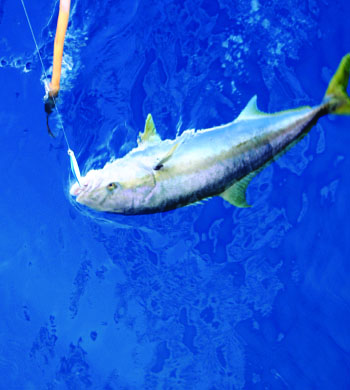 There are several ways to rig live baits for fishing down to 50 fathoms. On a sportboat, the reversed dropper loop is best at these depths and the standard dropper loop rig works well in the shallower spots (20 fathoms or less) where there is less of a chance to hook rockfish.
There are several ways to rig live baits for fishing down to 50 fathoms. On a sportboat, the reversed dropper loop is best at these depths and the standard dropper loop rig works well in the shallower spots (20 fathoms or less) where there is less of a chance to hook rockfish.
Personally, on a private boat, I use the “Loreto Yellowtail” rig, which is basically a torpedo sinker tied to the main line and a six-foot leader attached to a snap swivel, which is attached to the bottom ring of the torpedo sinker. As this rig is lowered into the depths, a nose-hooked mackerel or sardine will swim freely behind the sinker until it is tracked down and inhaled by a big yellowtail.
We use a snap swivel to the torpedo sinker to prevent line twist and this can be pre-rigged and left in the live bait tank until the boat marks fish. With the bait already pinned on the hook, you simply swing the bait from the tank and down into the depths (or the same timing as the jig fishermen).
NOTE: This rig doesn’t work with more than four guys in the cockpit because the bait has too much freedom.
On a private boat, when the captain wants to make a move or not marking fish, wind the Loreto Rig up slowly to the surface and be ready for a bite on the retrieve. I like to hook my live baits from inside the mouth and up through the top jaw. The bite at this depth is just a steady pull; wind in the slack until you come tight with the fish.
Preparing Your Fish
Yellowtail is delicious when prepared properly. If not bled and iced down immediately, this member of the jack family takes on a gamey flavor. It all starts when the fish is up alongside the boat ready for the gaff; take your time and try for a head shot when the timing is right. A head shot will preserve the meat and keep the fish from thrashing on the deck.
Next, I like to take a pair of dikes and cut a gill raker on each side of the fish to help bleed the fish. At this point, I either place the fish head first into a running live bait tank to help bleed out, or I quickly transfer the fish into an insulated fish bag and cover the body with ice.
A fish prepared this way will provide tasty filets and world-class sushi. Finally, while there are all sorts of techniques, rigs and opinions being discussed here, the best tip of this article is get your time in on the water. Get out there while you can and connect with a big, old deep-water yellow!


to chum line
kite fishing
Participant or spectator
On a recent short mutiday trip became frustrated by the politics involved in kite fishing for bluefin. Have found my trip to be on an excellent boat great service and fine meals to be a micro chasm of todays favoring of a certain few. Since I fish alone and the sponsor or charter captain group provide a larger part of the revenue stream needed for the San Diego fleet a single person will be one of the last to participate in the kite. This system assigns numbers that are lower which are provided to each customer upon boarding. Kite fishing for Yellowfin tuna are not a problem because they are not boat shy and come to the boat using the kite as an invitation but bluefin normally targeted by brilliant fisherman who have figured away to catch them one at a time (as much as 300 yards behind the stern) while the majority of passengers watch. The result is a few celebrate while the majority become restricted along with losing valuable rail time. I suggested a lottery where numbers were drawn from a hat for the opportunity to participate but did not go over well with crew. If your joining one of the special trips out of San Diego be prepared to be an observer not a fisherman while kite fishing.
Chuck Barnett
Danville Cal
Great story great guide a great blog altogether. Thank for taking you rtime to write this wonderful blog. I really liked all the story and how you gradually made this and informative guide for Yellowtail fishing. I Would llike to go on a advanture like this real soon. Recently installed a livewell pump on my boat to keep the bait fresh. The journey is calling me. I can hear it.